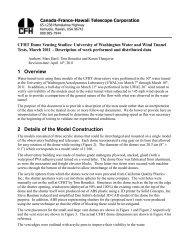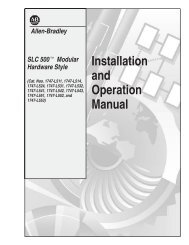Documentation [PDF] - Canada France Hawaii Telescope ...
Documentation [PDF] - Canada France Hawaii Telescope ...
Documentation [PDF] - Canada France Hawaii Telescope ...
Create successful ePaper yourself
Turn your PDF publications into a flip-book with our unique Google optimized e-Paper software.
Figure 28: Completeness calculation for the W3 stack CFHTLS_W_i_142939+514231. Left panel: The blue<br />
and red lines shows the completeness for point-like and extended sources respectively. The green dots show<br />
the best fitting functions which are used to derive the completeness values. Right panel: galaxy counts derived<br />
automatically by QualityFITS from this stack. The red line shows the expectations for the MegaCam i-filter. The<br />
green line is the 80% completeness limit of extended objects.<br />
4.3 Depth and completeness limits<br />
The depth of the survey tile is measured by the completeness limit. It is determined for each stack and<br />
each filter separately. The depth is also checked by using the galaxy counts computed after the production<br />
of each stack, as part of the QualityFITS analysis. All completeness galaxy count plots are available<br />
from the T0007 synoptic table 22 .<br />
To compute the completeness limit, we used image simulations produced by SkyMaker(Bertin, 2009).<br />
Noiseless images of point-like (stars or galaxy bulges) and disk-like (spiral galaxies) sources have been<br />
simulated by combining spheroid and disk models, using de Vaucouleur and exponential light profiles,<br />
respectively. The star and galaxy number densities of simulated sources correspond to the expectations<br />
for typical CFHTLS exposure times. Their slope and normalization are based on realistic luminosity<br />
function in a standard Λ-CDM cosmology (for galaxies), and are produced according to the transmission<br />
of the MegaCam filters.<br />
The sources are then convolved by a PSF that takes into account the pupil of the CFHT telescope (mirrors<br />
and arms) and other components of the PSF. The PSF is built by using the diffraction and the simplest<br />
aberration components of the CFHT telescope, as well as the typical atmospheric contributions that<br />
degrade long exposures. A set of simulations are produced with PSF FWHM ranging from 0.4 ′′ to 1.3 ′′ .<br />
For each stack, the simulated images with the closest PSF in FWHM size is then used to compute the<br />
final completeness. This “adaptive FWHM” method gives rise to larger dispersion in the completeness<br />
distribution compared to T0006. The T0007 completeness encompass both the exposure time and depth<br />
effect, as well as the image quality. The point source completeness is therefore more affected than the<br />
extended objects one.<br />
The completeness limit is then derived from the averaged completeness value over the central 10000×10000<br />
MegaCam fields. The statistics are computed in each field separately and for each filter. The output is<br />
the fraction of sources detected and measured as a function of magnitude. The magnitudes at 80% and<br />
22 http://terapix.iap.fr/cplt/T0007/table_syn_T0007.html<br />
41


![Documentation [PDF] - Canada France Hawaii Telescope ...](https://img.yumpu.com/26965302/53/500x640/documentation-pdf-canada-france-hawaii-telescope-.jpg)









